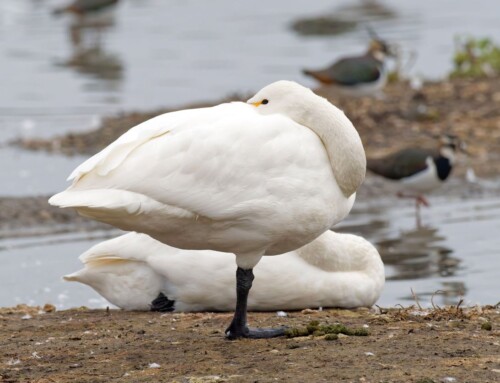Which is better for the reproductive success of Tengmalm’s Owls: an occasional feast or a steady availability of crumbs?
LINKED PAPER
Reproductive responses of temperate and boreal Tengmalm’s Owl Aegolius funereus populations to spatial and temporal variation in prey availability.
Markéta Zárybnická, Ondřej Sedláček, Pälvi Salo, Karel Šťaštný & Erkki Korpimäki.
IBIS. DOI: 10.1111/ibi. 12244
One could expect that the reproductive success of birds with large geographical distribution will be higher in the core of their breeding range than on its margin. Here we ask, how a nocturnal avian predator with wide Holarctic distribution – Tengmalm’s Owls Aegolius funereus – deals with contrasting ecological conditions of Northern (core of range) and Central (margin of range) Europe.
On a species level, populations occurring in different parts of the distribution range often face contrasting ecological conditions; these local conditions can modify the selective pressures affecting life-history characteristics, which in turn may lead to variation in reproductive strategies (Tieleman 2009). For example, Dark-eyed Juncos Junco hyemalis, which breed in North America across an extensive altitudinal gradient (Bears et al. 2009), provide a textbook example of within-species variation in life histories. Juncos inhabiting high elevations start to breed later and their reproductive season is constricted so that on average they are able to raise only half the number of young compared to conspecifics living at lower elevations. Lower reproductive success of the montane population is, however, balanced by higher between-year survival rates (Bears et al. 2009). Unfortunately comprehensive studies are scanty and our understanding of the variation in reproductive strategies among populations to maintain their viability is still far from satisfactory.
Birds of prey provide an especially suitable model for intraspecific comparisons as they tend to have large geographical ranges covering areas with contrasting ecological conditions, and show great variability in reproductive effort both within and between populations of the same species (Korpimäki & Hakkarainen 1991, Laaksonen et al. 2002). Moreover, they are well-explored example of huge intraspecific variation in life-history traits, as they are able to adjust their reproductive strategies across space and time according to actual food availability (Hakkarainen et al. 2003, Valkama & Korpimäki 1999). Furthermore, estimating the spatial and temporal availability of main foods of avian predators is relatively easy, making it possible to examine one of the main determinants of reproductive effort in birds (Martin 1987).
Variation in food abundance in both northern and temperate areas has a crucial impact on the reproductive strategies of avian predators, whereby seasons with high food availability lead to increases in clutch size (e.g. Lehikoinen et al. 2011) as well as current and lifetime reproductive success (e.g. Korpimäki 1992). However, at higher latitudes, voles, which comprise the dominant prey of most birds of prey, undergo regular 3-4 year cycles and great multi-annual and intra-seasonal changes of abundance (Korpimäki et al. 2005), while vole abundances tend to be relatively stable both within and between years, showing only moderate seasonal changes with low densities in the spring and higher densities in the autumn (Hanski et al. 1991). In addition, in temperate areas the diet of raptors and owls is additionally enriched with other species such as Apodemus mice (Zárybnická et al. 2013). However, studies comparing numerical and reproductive responses between geographically separated populations that also experience different prey dynamics have not been available so far.

Our primary intention was to compare the breeding density and performance of Tengmalm’s Owls in two geographically distant populations: a boreal population (in Finland) in the core area of the species’ breeding range and a temperate population (in the Czech Republic) at the southern limit of the breeding distribution range in the Western Palearctic. These study areas lie 1500 km from one another and differ substantially in prey availability: densities of main prey (voles and mice) at the temperate study site were consistently lower and more stable than prey populations at the boreal site where vole densities undergo both large inter-annual 3-year cyclic fluctuations and intra-seasonal changes in densities (Fig. 1). These differences in prey availability were closely related to variation in the breeding performance of the respective populations of Tengmalm’s Owls. In particular, owl breeding density showed greater inter-annual fluctuations in Finland where the number of breeding pairs positively correlated with main prey densities while no such relationship was observed at the Czech site. Clutch size was larger in Finland compared to the Czech site and positively correlated with main prey densities in both areas (Fig. 2).


However, there were no obvious differences between the two areas in the number of fledglings produced per nest. Owls that bred earlier in the season laid larger clutches and produced more fledglings per nest in both areas (Fig. 3). Decreased per nest offspring production in Finland resulted from higher nestling mortality, particularly in nests established later in the season (Fig. 4). Finally, despite higher prey densities and larger clutches at the Finnish site as well as higher nest predation at the Czech site, the overall breeding density and productivity of the Tengmalm’s Owls was much higher at the Czech site.

In this study, we have shown that the reproductive strategies of a nocturnal bird of prey vary in relation to different ecological conditions across environmental gradients. Although the boreal population of the Tengmalm’s Owl has well adapted its reproductive effort to high inter-annual food fluctuations, variable circumstances during the breeding season, in particular the abrupt changes in food availability can lead to increased nestling mortality and poor reproductive success. On the other hand, although the temperate owl population nesting at high density face frequent nest predation by Pine Martens, owls gain from the relatively stable prey abundance, more diverse prey community that offers both voles and mice as an important prey (Fig. 5), the longer nights that allow more time for foraging, and the lower level of interspecific competition with other vole-specialized avian predators. These findings offer an interesting case of extreme variation in the reproductive tactics between populations of the same species in relation to varying environmental conditions.

References and further reading
Bears, H., Martin, K., & White, G.C. 2009. Breeding in high-elevation habitat results in shift to slower life-history strategy within a single species. J. Anim. Ecol. 78: 365–375. View
Hakkarainen, H., Mykrä, S., Kurki, S., Korpimäki, E., Nikula, A. & Koivunen, V. 2003. Habitat composition as a determinant of reproductive success of Tengmalm’s owls under fluctuating food conditions. Oikos 100: 162–171. View
Hanski, I., Hansson, L. & Henttonen, H. 1991. Specialist predators, generalist predators, and the Microtine rodent cycle. J. Anim. Ecol. 60: 353–367. View
Korpimäki, E. 1992. Fluctuating food abundance determines the lifetime reproductive success of male Tengmalm’s Owls. J. Anim. Ecol. 61: 103–111. View
Korpimäki, E. & Hakkarainen, H. 1991. Fluctuating food supply affects the clutch size of Tengmalm’s owl independent of laying date. Oecologia 85: 543–552. View
Korpimäki, E., Oksanen, L., Oksanen, T., Klemola, T., Norrdahl, K. & Banks, P.B. 2005. Vole cycles and predation in temperate and boreal zones of Europe. J. Anim. Ecol. 74: 1150–1159. View
Laaksonen, T., Korpimäki, E. & Hakkarainen, H. 2002. Interactive effects of parental age and
environmental variation on the breeding performance of Boreal Owls. J. Anim. Ecol. 71: 23–31. View
Lehikoinen, A., Ranta, E., Pietiäinen, H., Byholm, P., Saurola, P., Valkama, J., Huitu, O., Henttonen, H. & Korpimäki, E. 2011. The impact of climate and cyclic food abundance on the timing of breeding and brood size in four boreal owl species. Oecologia 165: 349–355. View
Martin, T.E. 1987. Food as a limit on breeding birds – a life-history perspective. Annu. Rev. Eco. Syst. 18: 453–487.
Tieleman, I. 2009. High and low, fast or slow: the complementary contributions of altitude and latitude to understand life-history variation. J. Anim. Ecol. 78: 293–295. View
Valkama, J., & Korpimäki, E. 1999. Nestbox characteristics, habitat quality and reproductive success of Eurasian Kestrels. Bird Study 46: 81–88. View
Zárybnická, M., Riegert, J. & Šťastný, K. 2013. The role of Apodemus mice and Microtus voles in the diet of the Tengmalm’s owl in Central Europe. Pop. Ecol. 55: 353–361. View
If you want to write about your research in #theBOUblog, then please see here.






